
Siboglinidae is a family of polychaete annelid worms whose members made up the former phyla Pogonophora and Vestimentifera. The family is composed of around 100 species of vermiform creatures which live in thin tubes buried in sediment (Pogonophora) or in tubes attached to hard substratum (Vestimentifera) at ocean depths ranging from 100 to 10,000 m. They can also be found in association with hydrothermal vents, methane seeps, sunken plant material, and whale carcasses.

Any worm that lives in a marine environment is considered a water worm. Marine worms are found in several different phyla, including the Platyhelminthes, Nematoda, Annelida, Chaetognatha, Hemichordata, and Phoronida. For a list of marine animals that have been called "sea worms", see sea worm.

Polychaeta is a paraphyletic class of generally marine annelid worms, commonly called bristle worms or polychaetes. Each body segment has a pair of fleshy protrusions called parapodia that bear many bristles, called chaetae, which are made of chitin. More than 10,000 species are described in this class. Common representatives include the lugworm and the sandworm or clam worm Alitta.
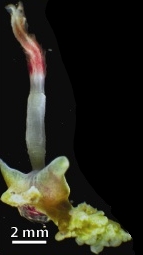
Osedax is a genus of deep-sea siboglinid polychaetes, commonly called boneworms, zombie worms, or bone-eating worms. Osedax is Latin for "bone-eater". The name alludes to how the worms bore into the bones of whale carcasses to reach enclosed lipids, on which they rely for sustenance. They utilize specialized root tissues for bone-boring. It is possible that multiple species of Osedax reside in the same bone. Osedax worms are also known to feed on the collagen itself by making holes in the whale's skeletal structure. These holes can also serve as a form of protection from nearby predators.
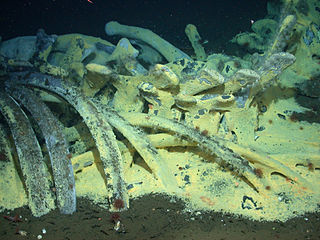
A whale fall occurs when the carcass of a whale has fallen onto the ocean floor at a depth greater than 1,000 m (3,300 ft), in the bathyal or abyssal zones. On the sea floor, these carcasses can create complex localized ecosystems that supply sustenance to deep-sea organisms for decades. This is unlike in shallower waters, where a whale carcass will be consumed by scavengers over a relatively short period of time. Whale falls were first observed in the late 1970s with the development of deep-sea robotic exploration. Since then, several natural and experimental whale falls have been monitored through the use of observations from submersibles and remotely operated underwater vehicles (ROVs) in order to understand patterns of ecological succession on the deep seafloor.

A deep-sea community is any community of organisms associated by a shared habitat in the deep sea. Deep sea communities remain largely unexplored, due to the technological and logistical challenges and expense involved in visiting this remote biome. Because of the unique challenges, it was long believed that little life existed in this hostile environment. Since the 19th century however, research has demonstrated that significant biodiversity exists in the deep sea.
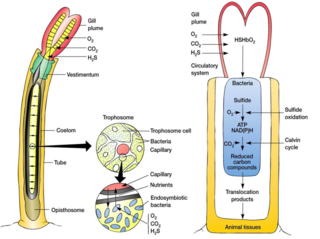
A trophosome is a highly vascularised organ found in some animals that houses symbiotic bacteria that provide food for their host. Trophosomes are contained by the coelom of the vestimentiferan tube worms and in the body of symbiotic flatworms of the genus Paracatenula.

Osedax roseus is a species of bathypelagic polychaete worm that lives at abyssal depths and is able to sustain itself on the bones of dead whales. The species is found in the North East Pacific.
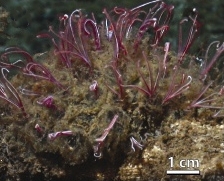
Osedax frankpressi is a species of bathypelagic polychaete worm that lives on the seabed and sustains itself on the bones of dead whales. It can be found in the East North Pacific Ocean. The specific epithet is named in honor of Frank Press "for his distinguished service to science".
Osedax japonicus is a species of bathypelagic polychaete tube worm that lives at great depths on the seabed and is able to sustain itself on the bones of a dead whale. It was first described in 2006 from a sunken sperm whale carcase near Kyushu, Japan.
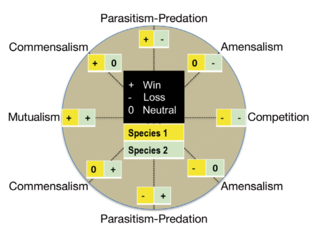
Microbial symbiosis in marine animals was not discovered until 1981. In the time following, symbiotic relationships between marine invertebrates and chemoautotrophic bacteria have been found in a variety of ecosystems, ranging from shallow coastal waters to deep-sea hydrothermal vents. Symbiosis is a way for marine organisms to find creative ways to survive in a very dynamic environment. They are different in relation to how dependent the organisms are on each other or how they are associated. It is also considered a selective force behind evolution in some scientific aspects. The symbiotic relationships of organisms has the ability to change behavior, morphology and metabolic pathways. With increased recognition and research, new terminology also arises, such as holobiont, which the relationship between a host and its symbionts as one grouping. Many scientists will look at the hologenome, which is the combined genetic information of the host and its symbionts. These terms are more commonly used to describe microbial symbionts.
Ophryotrocha craigsmithi is a species of polychaete worm. O. craigsmithi is named after Craig R. Smith. This species is similar to Palpiphitime lipovskyae and O. Platykephale, among others, in having branchial structures dorsally and ventrally. It differs from O. platykephale in the shape of its prostomium and parapodia. Palpiphitime lipovskyae has jaws of both P- and K-type, while no specimens of O. craigsmithi have been found with K-type jaws thus far. Ophryotrocha craigsmithi differs from P. lipovskyae genetically, but also by the presence of a prominent ventral chaetal lobe with a bulging simple chaeta in the former.
Ophryotrocha longicollaris is a species of polychaete worm, first found on deep sea whale fall and wood fall habitats in the north-east Pacific, off the southern Californian coast. This species and Ophryotrocha magnadentata are sister species; together with O. nauarchus and O. flabella, it falls in a clade including O. globopalpata and Exallopus jumarsi from the shallow North Atlantic.
Ophryotrocha magnadentata is a species of polychaete worm, first found on deep sea whale fall and wood fall habitats in the north-east Pacific, off the southern Californian coast. This species and Ophryotrocha longicollaris are sister species; together with O. nauarchus and O. flabella, it falls in a clade including O. globopalpata and Exallopus jumarsi from the shallow North Atlantic.
Ophryotrocha nauarchus is a species of polychaete worm, first found on deep sea whale fall and wood fall habitats in the north-east Pacific, off the southern Californian coast. The species is sexually dimorphic, males having appendages on their first chaetiger.
Ophryotrocha flabella is a species of polychaete worm, first found on deep sea whale fall and wood fall habitats in the north-east Pacific, off the southern Californian coast. It is similar to Ophryotrocha globopalpata, possessing some morphological differences, although genetic divergence is low between them.
Ophryotrocha langstrumpae is a species of polychaete worm, first found on deep sea whale fall and wood fall habitats in the north-east Pacific, off the southern Californian coast. It is closely related to Ophryotrocha scutellus and Ophryotrocha batillus.
Ophryotrocha batillus is a species of polychaete worm, first found on deep sea whale fall and wood fall habitats in the north-east Pacific, off the southern Californian coast. It is very similar to Ophryotrocha scutellus, yet differs from the latter genetically.
Kemp Caldera and Kemp Seamount form a submarine volcano south of the South Sandwich Islands, in a region where several seamounts are located. The seamount rises to a depth of 80 metres (260 ft) below sea level; the caldera has a diameter of 8.3 by 6.5 kilometres and reaches a depth of 1,600 metres (5,200 ft). The caldera contains several Hydrothermal vents, including white smokers and diffuse venting areas, which are host to chemolithotrophic ecological communities. The seamount and caldera, which were discovered by seafloor mapping in 2009, are part of the South Georgia and the South Sandwich Islands Marine Protected Area.
Frenulata, "beard worms", is a clade of Siboglinidae, "tube worms". They are one of four lineages with numerous species. They may be the most basal clade in the family. Despite being the first tube worms to be encountered and described, they remain the least studied group. This is because of their slender shape, they often get destroyed as a result of being caught as bycatch or poor preservation. They are found primarily in deep, muddy sediments, cold seeps, and anoxic firth sediments.








